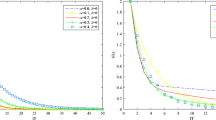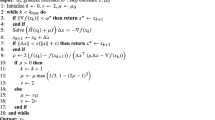Abstract
During the iterations of interior point methods symmetric indefinite systems are decomposed by LD̂L T factorization. This step can be performed in a special way where the symmetric indefinite system is transformed to a positive definite one, called the normal equations system. This approach proved to be efficient in most of the cases and numerically reliable, due to the positive definite property. It has been recognized, however, that in case the linear program contains “dense” columns, this approach results in an undesirable fill–in during the computations and the direct factorization of the symmetric indefinite system is more advantageous. The paper describes a new approach to detect cases where the system of normal equations is not preferable for interior point methods and presents a new algorithm for detecting the set of columns which is responsible for the excessive fill–in in the matrix AA T. By solving large–scale linear programming problems we demonstrate that our heuristic is reliable in practice.
Similar content being viewed by others
References
R.P. Amestoy, T.A. Davis, and I.S. Duff, “An approximate minimum degree ordering algorithm,” SIAM Journal on Matrix Analysis and Applications, vol. 17, no. 4, pp. 886–905, 1996.
E.D. Andersen, J. Gondzio, C. Mészáros, and X. Xu, “Implementation of interior point methods for large scale linear programs,” in Interior Point Methods of Mathematical Programming, T. Terlaky (Ed.), Kluwer Academic Publishers, 1996, pp. 189–252.
J.R. Bunch and B.N. Parlett, “Direct methods for solving symmetric indefinit systems of linear equations,” SIAM Journal on Numerical Analysis, vol. 8, pp. 639–655, 1971.
I.S. Duff, N.I.M. Gould, J.K. Reid, J.A. Scott, and K. Turner, “The factorization of sparse symmetric indefinite matrices,” IMA J. Numer. Anal. vol. 11, pp. 181–204, 1991.
R. Fourer and S. Mehrotra, “Solving symmetric indefinite systems in an interior point method for linear programming,” Mathematical Programming, vol. 62, pp. 15–40, 1993.
D. Goldfarb and K. Scheinberg, “A product-form Cholesky factorization method for handling dense columns in interior point methods for linear programming,” Mathematical Programming, vol. 99, no. 1, pp. 1–34, 2004.
J. Gondzio, “Multiple centrality corrections in a primal-dual method for linear programming,” Computational Optimization and Applications, vol. 6, no. 137–156, 1996.
N.K. Karmarkar, “A polynomial-time algorithm for linear programming,” Combinatorica, vol. 4, pp. 373–395, 1984.
I.J. Lustig, R.E. Marsten, and D.F. Shanno, “The interaction of algorithms and architectures for interior point methods,” in Advances in Optimization and Parallel Computing, P.M. Pardalos (Ed.), Elsevier Sciences Publishers B.V. 1992, pp. 190–205.
I.J. Lustig and E. Rothberg, “Gigaflops in linear programming,” Operations Research Letters, vol. 18, no. 4, pp. 157–165, 1996.
I. Maros and C. Mészáros, “The role of the augmented system in interior point methods,” European Journal on Operational Research, vol. 107, no. 3, pp. 720–736, 1998.
C. Mészáros, “Fast Cholesky factorization for interior point methods of linear programming,” Computers & Mathematics with Applications, vol. 31, nos. (4/5), pp. 49–54, 1996.
C. Mészáros, “On free variables in interior point methods,” Optimization Methods and Software, vol. 9, pp. 121–139, 1997.
C. Mészáros, “On the sparsity issues of interior point methods for quadratic programming,” Working paper WP 98-4, Computer and Automation Institute, Hungarian Academy of Sciences, Budapest, 1998.
C. Mészáros, “The BPMPD interior-point solver for convex quadratic problems,” Optimization Methods and Software, vol. 11/12, pp. 431–449, 1999.
C. Mészáros, “On the Cholesky factorization in interior point methods,” Computers & Mathematics with Applications, vol. 50, pp. 1157–1166, 2005.
C. Mészáros, “On the numerical issues of interior point methods,” Working paper WP 2005-3, Computer and Automation Institute, Hungarian Academy of Sciences, Budapest, 2005.
C. Mészáros, “On the performance of the Cholesky factorization in interior point methods on Pentium 4 processors,” CEJOR, vol. 13, no. 4, pp. 289–298, 2005.
C. Mészáros and U.H. Suhl, “Advanced preprocessing techniques for linear and quadratic programming,” OR Spectrum, vol. 25, pp. 575–595, 2004.
H.D. Mittelmann, “Benchmarking Interior Point LP/QP Solvers,” Optimization Methods and Software, vol. 12, pp. 655–670, 1999.
H.D. Mittelmann and P. Spellucci, “Decision tree for optimization software,” World Wide Web, http://plato.la.asu.edu/guide.html, 1998.
C Roos, T. Terlaky, and J.-Ph. Vial, Theory and Algorithms for Linear Optimization: An Interior Point Approach. John Wiley & Sons, 1996.
R.J. Vanderbei, “Symmetric quasi-definite matrices,” SIAM Journal on Optimization, vol. 5, no. 1, pp. 100–113, 1995.
R.J. Vanderbei and T.J. Carpenter, “Symmetric indefinite systems for interior point methods,” Mathematical Programming, vol. 58, pp. 1–32, 1993.
M.H. Wright, “Some properties of the Hessian of the logarithmic barrier function,” Mathematical Programming, vol. 67, pp. 265–295, 1994.
S.J. Wright, Primal–dual interior point methods. SIAM, T57.74.W75, University Science Center, Philadelphia, 1997.
S.J. Wright, “Stability of linear algebra computations in interior-point methods for linear programming,” SIAM Journal on Matrix Analysis and Applications, vol. 18, pp. 191–222, 1997.
Author information
Authors and Affiliations
Corresponding author
Additional information
This work was supported in part by the Hungarian Scientific Research Fund OTKA K60480.
Rights and permissions
About this article
Cite this article
Mészáros, C. Detecting “dense” columns in interior point methods for linear programs. Comput Optim Appl 36, 309–320 (2007). https://doi.org/10.1007/s10589-006-9008-6
Published:
Issue Date:
DOI: https://doi.org/10.1007/s10589-006-9008-6




